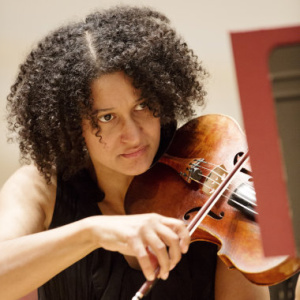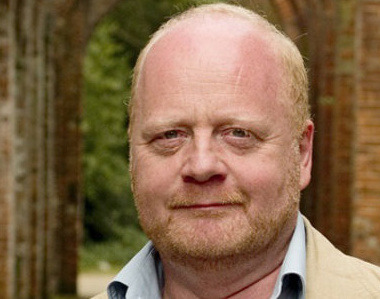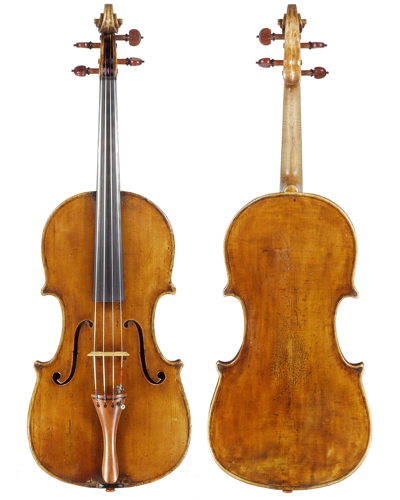John Woolrich has always been inspired by the sound of string instruments, as his extensive list of compositions attests – from his Three Pieces for Viola of 1993 to his double concerto for viola and bass, To the Silver Bow, which will be premiered in February 2016, and many works in between. When composing, he likes to have a specific sound as his inspiration: ‘You have to have a sound in your head. That doesn’t mean you couldn’t write for someone you don’t know, though. The first string concerto I wrote was for the violist Paul Silverthorne and I knew him very well. But I wrote the Cello Concerto for Steven Isserlis and didn’t know his playing, so I listened to a lot of his recordings. I wouldn’t write in the abstract for a violinist or a cellist.’

Jane Atkins, one of the many violists to have played Ulysses Awakes. ‘In many ways it’s not my piece any more,’ says Woolrich. Photo: Marco Borggreve
Ultimately, though, he recognizes that his music will evolve with the musicians who perform it. ‘You imagine something specific and then hope it can work with a wide variety of instruments and performing styles. If your piece is limited to the first performer there’s something wrong with it. Just as you don’t know who is going to be in the audience, you don’t know who the player will be. Ulysses Awakes [for viola and orchestra] has had many performances now: Yuri Bashmet, Maxim Rysanov, Jane Atkins. They all make glorious sounds with the viola, but quite distinct. In many ways it’s not my piece any more.’
The instruments themselves are part of this process, both in inspiring Woolrich, and in affecting the outcome: ‘There’s an enormous variety in instrument sound, particularly in basses and violas. Every viola sounds slightly different, and wonderful in diverse ways. It opens up my imagination. And while the other bits of your memory drop off as you age as a composer, you acquire more knowledge of the noises instruments make, and their dark, secret corners.’
How has this knowledge evolved throughout his career? ‘When they’re young, many composers over-write for instruments. They get out all the books and do too much. One of the great moments in growing up as a composer is when you step back from that and let the instrument speak. When I wrote my Oboe Concerto for the BBC Proms in 1996 I’d never successfully written for the oboe and I was trying too hard. Then one day I looked at Mozart, who writes very well for oboe and its register. He makes the instrument sing, and I think that’s true of string instruments, because you can think of them echoing the human voice. The more you think of instruments as singing, particularly string instruments, the more you let their natural sounds come out.’
Indeed, the concertos and solo pieces that Woolrich has written for stringed instruments are characterized by their lyricism, which is prioritized over fast, intellectual or aggressive music. He explains: ‘I’ve never wanted to write virtuosic music. This isn’t to say I don’t like writing flashy music, but it’s not important to me to create something that makes a musician’s fingers smoke. Sometimes a piece is quite difficult or it’s emotionally hard for the player, but I’ve never wanted to push technique to do that.’
What are Woolrich’s favourite techniques for stringed instruments? ‘I love sul tasto and I’m always encouraging players to go further and further up the fingerboard. I love that quality of sound. There’s another technique, which Berio used, which is a vertical tremolo, where you hold the heel of the bow very firmly in the fist and you move from sul pont to sul tasto very quickly. It’s ghostly, and when you have a whole string section doing it it’s a marvelous noise. I love the ethereal sounds of string instruments, as opposed to making a violin sound bright and out in the sunshine.’
Indeed, he seems to revel in the deeper sounds of the string register, and explains his overall conception of string sounds: ‘I don’t know why, but I always think of the violin and the cello going together, and the viola with the bass. The viola and bass are dark, nocturnal, mysterious, full of acoustical mysteries, whereas the violin and cello are more out in the light. The viola is my favorite instrument, because of its mysterious rich quality. I’m very happy writing for it.’
The main challenge in writing concertos for the lower registers lies in the orchestration, where the voice of a single wooden box needs to be heard through the texture of a whole orchestra, as Woolrich explains: ‘You have such a huge imbalance of forces. There’s hardly any instrument that can hold its own against the whole symphony orchestra. Either you think of this as a dreadful problem or it gets the creative juices working.’

John Woolrich: ‘I love sul tasto and I’m always encouraging players to go further up the fingerboard.’ Photo: Maurice Foxall
What solutions has he found? ‘I’ve never done the 19th-century virtuosic thing of pitting the soloist against the orchestra, trying to get the soloist to shut it down. With the Viola Concerto everything is pianissimo, supported by flute and harp. The Cello Concerto alternates between solo and tutti, or solo with hushed tutti. But the Violin Concerto is full of ensemble playing, because the violin is on top so it can sing out more easily. It’s exciting to find a way of keeping the poetry of this uneasy balance between the one and the many. All the ideas that come out of that thought become the beginning of how you think about the concerto.’
For Woolrich, the composer’s role is ultimately transitory. ‘I agree with Michael Tippett, who said his job ended at the double bar. You can sit in a rehearsal, but unless something is going desperately wrong, you should leave well alone. If I happen to be in a rehearsal of Ulysses Awakes and a player asks how a particular section goes, I don’t know any more, because there’s been such a rich range of interpretations, all of which are fine by me. I’m happy to trust the players. You try to make an image and see if anyone will respond to it, whether it’s an audience member or a player. When that works and the player responds enthusiastically, I feel grateful. I know my message in a bottle has been perceived and read.’
Formerly editor of The Strad, Ariane Todes is now a freelance writer and editor.
